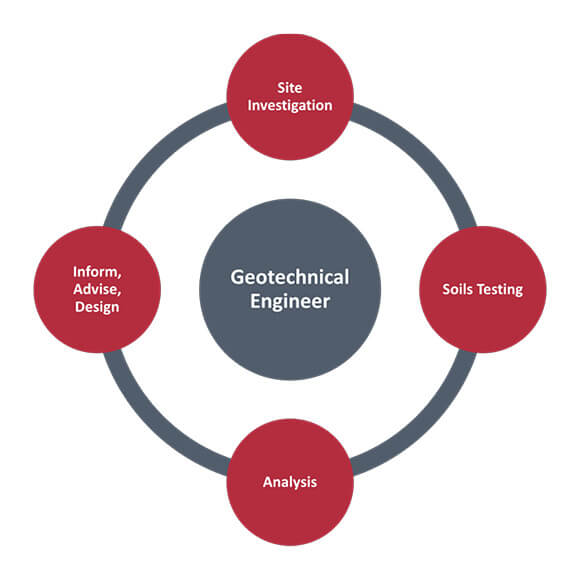Some Known Details About Geotheta
Some Known Details About Geotheta
Blog Article
The Greatest Guide To Geotheta
Table of ContentsAll About GeothetaNot known Facts About GeothetaThe Basic Principles Of Geotheta The smart Trick of Geotheta That Nobody is Talking About
They work together with civil designers, structural engineers, architects, and various other specialists to incorporate geotechnical considerations into the total job layout and building and construction procedure. This requires effective synergy, sychronisation, and interaction to make sure that the geotechnical facets straighten with the task goals and meet governing requirements.Mining & Materials Engineering: Concepts of exploration, infiltration rates, and factors affecting the choice of boring method. Blasting techniques in surface area and below ground functions. Mechanical and continual methods to fragmentation, including longwall shearing and fullface boring.
Modelling of fragment and fragment size circulations; comminution as a transfer function. Comminution modern technology: squashing, grinding, size category. Integrated evaluation of fragmentation and comminution procedures. Offered by: Mining & Materials Engineering.
Geotheta - An Overview
Bachelor's degree programs in civil, geotechnical, geological, and environmental design normally last 4 years and consist of general education courses in English, social science, and the humanities, in addition to training courses in advanced maths, architectural geology, and fluid mineralogy. (https://my-store-fc66c1.creator-spring.com/)
Geotechnical design entails the assessment of the dirt and rock problems at a certain website, and their effects for the advancement of that website. As a lot of structures depend on the ground for support, it lacks surprise that an in-depth understanding of the ground problems, and the suitability of foundation systems, are essential to the long-lasting stability and performance of the building or framework.
Specialising in the investigation of geological developments and ground behaviour, geotechnical engineers do scientific examinations and testing to recognize the influence these geological formations may carry the layout and building of building, civil and infrastructure tasks. This expertise is crucial for the style and building and construction of buildings, roads, passages, dams, bridges, and water and sewer systems.
The geotechnical group at Douglas Partners routinely talk to engineers, layout designers, designers, and building contractors to make recommendations on design and advancement proposals to ensure that the developed frameworks are suitably made for the ground conditions. The layout of footing systems requires to think about the weight of the framework, the ability of the ground to support that weight with each other with movement resistances and effective building and construction.
The Facts About Geotheta Uncovered
This job is greatly simplified by the usage of our Douglas Map geospatial platform which makes this info readily easily accessible in a simple to make use of internet internet browser interface. A geotechnical designer will route the exploration of boreholes and examination pits to accumulate soil and various other samples, and additionally analyze surface attributes and ground direct exposures to form a geotechnical design of the subsurface problems.
Depending upon the project kind and ground conditions experienced, lab screening might to name a few points analyze stamina, compressibility, reactivity and/or permeability of dirt and rock samples. Hereafter information is gathered and collected, the results are utilized for a geotechnical model of the site, which is typically provided as areas throughout the website.

A geotechnical investigation by nature can only assess the ground conditions at the areas drilled or dug deep into. Natural variants in soil and rock conditions can take place across a website and in between examination locations. It is for that reason great method that the geotechnical designer be kept throughout building and construction of the project to provide on-site verification that the ground conditions run into are constant with the assumptions and suggestions supplied in the geotechnical investigation report.
Indicators on Geotheta You Should Know
Geotechnical designers utilize their comprehensive expertise of soil and rock to examine danger and address problems on diverse infrastructure projectsGeotechnical engineering is a specialist branch of civil design which checks out the behaviour of planet products and the application of soil and rock mechanics. Tailings Engineer. As a geotechnical designer, you will certainly examine the physical, mechanical and chemical residential properties of soil and rock in order to develop structures, preserving frameworks and earthworks
Geotechnical design is very closely linked to and overlaps with, both engineering geology and ground engineering - https://www.cheaperseeker.com/u/geotheta. It's feasible to be experts in geotechnics or benefit a geotechnical firm yet be understood as a design geologist or a ground designer. As a geotechnical designer, you'll need to: develop and maintain relationships with clients and other professionals involved in the site, throughout each projectmaintain safety and security criteria on site bear in mind cost ramifications my link when you make recommendationsstudy geological maps and airborne pictures from a variety of resources and from different time periodsexamine building and construction prepares to see exactly how practical they are based upon your understanding of the siteinvestigate dangers or geological threats for the sitesearch for eco delicate functions, such as garbage dump start to develop valid and interpretive ground modelsplan field investigationsdrill and evaluate samples of bedrock, dirt, groundwater and additional materials manage various other experts on sitesolve technical concerns as they develop, such as unexpected frameworks at drill sitesmonitor conditions throughout and after building to make certain structures are stable in the brief and lengthy termadding information collected on website to your initial researchcreating geotechnical estimations, drawings, and 2 or three-dimensional computer designs translating the datamaking suggestions about the proposed usage of the site

Report this page